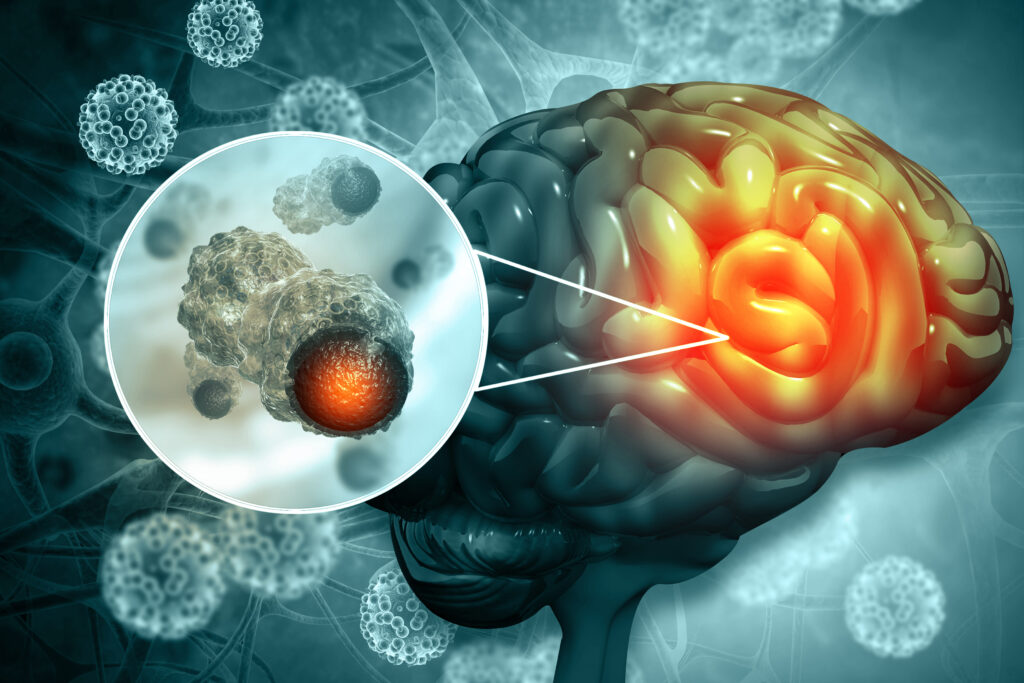Brain Tumors
Brain tumors are very variable in nature while their frequency seems to be increasing. We can often anticipate their nature by doing a multimodal MRI, but generally a surgical intervention is necessary to determine with certainty the precise diagnosis and the nature of the tumor. This step is important to know if a complementary treatment to the surgery should (or not) be organized.
A brain tumor, as all tumors, is a mass or growth of abnormal cells in the brain. There is many different types of brain tumors. Some brain tumors are benign or noncancerous, and some brain tumors are malignant or cancerous. In addition, brain tumors can initiate from within the brain itself (like gliomas), from outside the brain but inside the skull (like meningiomas and neurinomas), both are called primary brain tumors, or tumors can begin in other parts of the body then spread to the brain as secondary brain tumors (metastasis).
Brain tumor growth is very different between tumor types. The growth rate and the location of the brain tumor, as well as a basic status of the patient, will affect the function of the nervous system. These parameters are considered to choose the best treatment option.
Signs and Symptoms
Please find here the most frequent signs and symptoms that can evoke the presence of a brain tumors. Don’t hesitate to make an appointment with your doctor if you have persistent of any of these signs and symptoms.
- New onset or change in pattern of headaches, as headaches that become more frequent and more intense
- Nausea or vomiting without explaining cause
- Progressive loss of sensation or movement in an arm, a leg, or one side of the face
- Speech difficulties
- Confusion
- New onset of seizures
- Vision problems, like new descrease, blurred, double or amputated vision
- Fatigue
- Changes in personality or behavior, difficulty to make decisions or to follow simple orders
- Dysequilibrium or vertigo, walking difficulties
- Decrease in hearing
These signs and symptoms can appear rapidly like in several days, or very slowly like several months, depending on the growth rate or location in the brain. The more the growth rate is elevated, the more the tumor is aggressive and malignant, and vice versa.
Diagnosis
The CT scan, is often the first diagnostic examination performed when doctors suspect the presence of a brain tumor. Indeed, most of the brain tumors are clearly visible with this type of imaging. Injecting a contrast product, i.e. a dye product, into your bloodstream before the examination allows you to obtain a more precise image of your pathology.
MRI is the reference examination for the radiological diagnosis of brain tumors. Compared to CT scan, MRI offers a much more detailed picture of the brain. In the same way as with the CT scan, the MRI is carried out after the injection of a contrast product.
The histopathological examination is the laboratory study of tumor cells. It can be performed on tumors removed by surgery or by biopsies performed by stereotactic procedure on surgically inoperable tumors. Histopathological examination is the only method that can absolutely confirm and give the type of a brain tumor. In general, the more tumor tissue is available, the more accurate is the diagnosis. However, histopathological examination may provide more accurate results when performed in experienced centers where pathologists (specialist doctors who examine tissue after it has been removed) have extensive experience in analyzing brain tumors. Therefore, a detailed analysis of the tumor cells by a neuropathologist is crucial.
Please find below information about the most frequent brain tumors.

